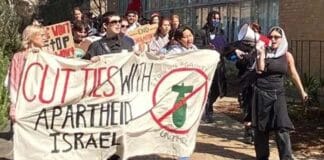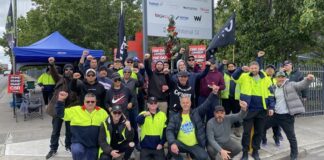Jad Bouharoun is a socialist based in Paris who has been part of the wave of yellow vests protests in France. He will visit Australia in April to speak at Solidarity’s Keep Left conference.
Below is part of a speech he gave to explain where the movement came from, who are the yellow vests and how left-wing activists should respond.
ʻThe fuel tax hike announced by French President Emmanuel Macron that started the movement was only the straw that broke the camel’s back.
This movement emerged after a decade of global economic crisis and austerity policies adopted by all the European governments. Macron is trying to apply further violent neo-liberal measures—the classic recipe of tax cuts for the very rich, cuts to public services, privatisation of public services and pensions as well as indirect taxation like the fuel tax, which mostly hit people who have less money.
Even before the yellow vests emerged Macron was perceived as the president of the rich. After a year in power Macron was announced as the saviour of the European neo-liberal centre. He is today the most unpopular president in the history of France. For the past ten years we’ve had three presidents each with a new record low in approval ratings.
We’ve had a very sharp polarisation which is what is happening throughout Europe. The past few years have seen large sectors of the working class going on strike and students occupying their schools and universities. At the same time there is a polarisation to the right: in the last election in 2017 the far right candidate got ten million votes.
The yellow vests movement emerged in this context. The vast majority of the people taking part are working class: in work, unemployed, retired or juggling two jobs to make ends meet. They all say they don’t have enough money to make ends meet and they hate Macron and want him to resign.
This movement is really outside of the organised working class. One in two working people in France have never been part of a union. These are people who usually live in smaller towns and work in small workplaces. Very often they have to travel 30 or 50 kilometres to get to work, so fuel is a major expense—which is why the tax is so hated.
A minority of the movement are small business owners who want less taxes but are opposed to raising wages because this means they will have to pay their workers more.
Although the most visible and spectacular demonstrations are in Paris, most participants in the yellow vest movements are in smaller gatherings of hundreds of people all over the country blocking roads. All of this means the movement is very uneven.
Political ideas
The far right have tried to hijack the movement on social media and appear as its representatives. Many participants have explicitly rejected these attempts. Some fascist groups have been kicked out of demonstrations.
People are moving into struggle using symbols that are unusual for the left, like the French flag and singing the national anthem, including in a minority of cases homophobic or racist ideas. This is not surprising given the mainstream political parties and the media have resorted to racism and Islamophobia.
As the movement goes on the anti-racist and working class movement are realising that we need to stand shoulder to shoulder with the yellow vests but to bring our ideas and our arguments.
The fact that they’re involved in struggle is actually starting to change their ideas.
The violence comes mainly from the police—on one Saturday the police fired 10,000 grenades in Paris alone, one grenade every four or five seconds on average. Many people are starting to realise that the police are on the side of the rich.
Another idea that some in the yellow vests had was that trade unions were useless.
But we’ve had local convergences between trade unions and the yellow vests and both are realising that they need each other to win.
Finally sections of the anti-racist movement have decided to join the demonstrations bringing their own anti-racist demands. This is important because if we can learn one thing from France in the last few years it’s that traditional class struggle—strikes, demonstrations, occupations—create a favourable environment for anti-racists but do not make racism disappear automatically.
The French ruling class will use racism and Islamophobia whenever they are in trouble.
The images of riots and barricades in Paris are a reminder of what happened in 1968 but the economic impact of the yellow vests at the moment is not so big.
In May 1968 the economic impact was huge because there was also the largest general strike in the history of the country. Macron is already in big trouble politically, what we need now is more strike action to really finish him off. This will not come from above, it needs to be built from below in every workplace.ʼ





